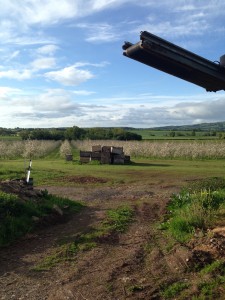
Counting birds at 4am: my PhD explained
Category : Fieldwork
I thought it was time to tell you all why on earth I have been getting up at silly o’clock to count birds in the orchards of Herefordshire. It was also too windy for the birds today, so I’ve had a day off!
A recent BBC article writing about the benefits of organic farming to wildlife and biodiversity nicely introduces the thought process behind my PhD project. It highlights that having a few organic fields on a farm may increase biodiversity over the whole farm, making room for more species to persist alongside our food production areas. However, this comes at a cost – lower yields. You might wonder: if organic fields produce less food how do farmers still make as much money as non-organic farmers? This is important to consider, as we can see organic farming is important for wildlife, which we try to preserve and protect, but it may be detrimental to farmers, and their pockets.
As we strive to produce more and more food on agricultural lands without expanding agriculture into surrounding woodlands and grasslands, it may cause farming practices to intensify – for example using more pesticides. This land sparing versus land sharing debate is quite large and discusses whether agricultural intensification is best – where protected areas are only areas left for wildlife or whether wildlife-friendly farming, which integrates wildlife and agriculture, is the way forward.
But what if wildlife-friendly farmers can make as much money as conventional ones? Biodiversity has been known to provide benefits to farming, such as pollination and pest/biological control services. These are known in the scientific community as ‘ecosystem services’. The hot topic ecosystem service currently is pollination, with news of wild bumblebee populations halving, potentially due to nicotine-like pesticides sprayed on fields. Pollination is vital to some crops, such as apples, where a higher quality and quantity of crop is produced when pollination has occurred. This problem comes to light when farmers are forced to boost farm pollinator populations by buying bees in a box.
Another ecosystem service, the one I am focussing on, is pest control. There are various studies showing that insects and birds, found naturally in our landscape, can act as a pest control and reduce damage to crops. Earwigs control aphid populations and Great Tits have been seen to reduce caterpillar damage in orchards.
Surely by using our local pest regulators to do the dirty work for us, farmers can save money? Pesticide applications are very expensive and a major cost incurred, reiterated by most farmers involved in my study. I am trying to find out whether a pest control service exists in apple orchards of Herefordshire, and whether that service has monetary value to farmers. In other words, will farmers make more money by not using pesticides? Apple yields and pest levels will also be taken into account to make sure overall profits are looked at rather than just the costs spent on the farm.
The way we are going to answer this question is to measure biodiversity on four orchard categories which range from high – low biodiversity levels and high – low pesticide use. Beetles and birds are going to be used as our indicators for biodiversity, which we will measure on each orchard.
After measuring the amount of natural habitat, such as hedgerows and woodland areas, and biodiversity on each farm we will look at whether or not that biodiversity is acting as a pest control service to the orchard. By using farm pesticide records and closely monitoring Blue Tits and Great Tits, using nest box cameras, we should be able to determine whether those bird species are acting as an ecosystem service and saving the farmer from spraying more pesticides than they would have to if those birds weren’t around.
By installing nest box cameras in some of the orchards we should hopefully catch pictures of what Blue Tits and Great Tits are eating from the orchards, to capture whether the insects they are catching are anything beneficial to farmers or not. Personally, I hope they are… but we will see.
Read my next blog “Curly blonde pigs, Cow panic and a Birdy Dilemma” to see how my fieldwork is going so far.
Thanks to all the farmers who have kindly agreed to let me roam around their farms counting birds in Herefordshire, Worcestershire and Gloucestershire. I wouldn’t have a PhD project without you.
Written by Charlotte Selvey and first posted here in May 2015.




